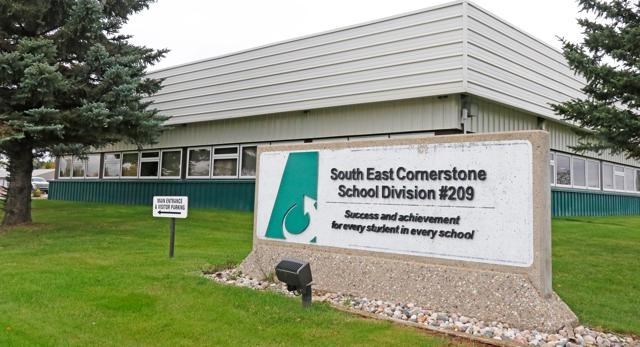SOUTHEAST SASK. — They call it the “wall walk” and it’s done on a regular basis by a team of Â鶹ÊÓƵ East Cornerstone Public School Division (SECPSD) administration leaders. The purpose of the “walk” is to bring board members up to date on the progress being made on various educational fronts through the process of “walking” them through a series of colourful graphs and charts that bedeck the school division’s conference room’s west wall.
The “walk” on June 19, during the board’s monthly business meeting, began with superintendent Catherine Hiltz going through details of the school survey system and student learning processes as the educators find out how and what students are absorbing or, as she said, “do they value what they’re learning?”
She said SECPSD is around the provincial average of overall success and that has been consistent over the past four years, or since Cornerstone started submitting detailed data that are accumulated and put into the graph and chart templates.
“We are pretty well on track but with a little bit of work to do yet,” she told the board.
Jacquelene Gibbs, the early years co-ordinator, noted the Early Learning-ECIP program has seen significant caseload growth over the past three quarters as families reconnect with their communities.
As children enter kindergarten, teachers use the Early Years Evaluation (EYE) system to learn about each student’s learning needs and reassess in the spring to support each student’s transition to Grade 1. Gibbs reports, kindergarten students were able to achieve steady growth over the school year.
However, in comparison to the past four years, she noted a slight increase in children who required additional assistance. What had been a five per cent need was now around the 10 per cent mark. Gibbs noted, “The EYE allows us to monitor and carefully plan for student success at the division-, school-, and classroom level.”
ECIP caseloads and EYE results are shared with the Ministry of Education, so too are reading results at Grades 1-3 levels. Gibbs was pleased to report the highest level of achievement at the Grade 3 level over the past four years.
Cheryl Anderson, co-ordinator of student services, spoke about early literacy needs and the progress being made within that file using a basic benchmark system known as STARS to measure progress from Grades 1 through 6 and again for middle years students. She said historically, the data indicates a stability factor at Grade 7 and 9 levels as well as progress in other categories.
Hiltz returned to the colourful wall again to point out areas where the data helps inform the superintendents who can then look at grade results throughout the entire division and also look at the progress being made at individual schools.
Kevin Hengen, another area superintendent referred to the charts and graphs to outline progress being made within the world of mathematics from Grades 2 to 9, noting how the case studies are showing some “encouraging results in Grade 9” while also stating that by tracking yearly they are “improving year over year.” That has led to some encouraging reports overall in the Grade 8 and 9 levels.
Hiltz also noted that later years literacy results were also very encouraging.
Superintendent Jeff St. Onge took note and pulled data from the charts that focused on Indigenous students and how that data was incorporated into the overall sectors for First Nations students and others.
St. Onge added that similar trends were noted on the Indigenous student front compared with the non-Indigenous, including attendance.
Raylene Forseth, mental health co-ordinator, spoke about anxiety elements, using the data gleaned from the graphic examples.
She pointed out how there was a strong collaboration with counsellors regarding conflict resolutions within the schools as well as an overall reach and how advocacy measures in the schools would be deployed.
Nathan Johnson, superintendent of human resources, talked about behaviour and emotional supports and those that screen as requiring assistance year-over-year for the past four years, are provided assistance. He said he was happy to report an increase in the “green” zone on the charts, indicating positive results in the Grades 4 to 7 sectors, meaning some positive things were happening in most schools. He also spoke briefly on attendance figures, telling the board that “across the board, it’s better than last year,” and that students who are absent more than 20 per cent of the required time, are then listed as having a chronic problem that needed addressing.
The session ended with queries and votes of thanks from the board members and chairwoman Audrey Trombley.




